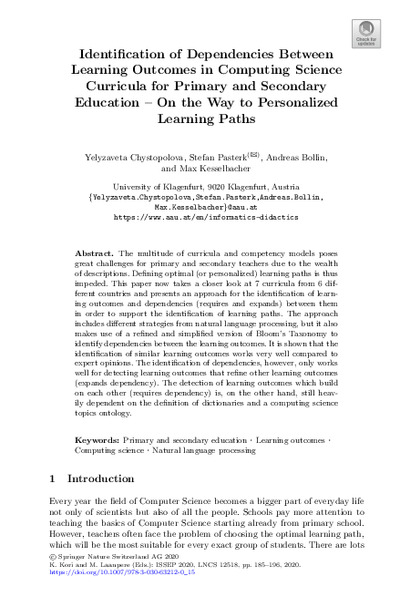Identification of Dependencies Between Learning Outcomes in Computing Science Curricula for Primary and Secondary EducationOn the Way to Personalized Learning Paths
Zu finden in: Informatics in Schools: Engaging Learners in Computational Thinking (Seite 185 bis 196), 2020
  |
 |
 Diese Seite wurde seit 3 Jahren inhaltlich nicht mehr aktualisiert.
Unter Umständen ist sie nicht mehr aktuell.
Diese Seite wurde seit 3 Jahren inhaltlich nicht mehr aktualisiert.
Unter Umständen ist sie nicht mehr aktuell.
 Zusammenfassungen
Zusammenfassungen
 The multitude of curricula and competency models poses great challenges for primary and secondary teachers due to the wealth of descriptions. Defining optimal (or personalized) learning paths is thus impeded. This paper now takes a closer look at 7 curricula from 6 different countries and presents an approach for the identification of learning outcomes and dependencies (requires and expands) between them in order to support the identification of learning paths. The approach includes different strategies from natural language processing, but it also makes use of a refined and simplified version of Bloom’s Taxonomy to identify dependencies between the learning outcomes. It is shown that the identification of similar learning outcomes works very well compared to expert opinions. The identification of dependencies, however, only works well for detecting learning outcomes that refine other learning outcomes (expands dependency). The detection of learning outcomes which build on each other (requires dependency) is, on the other hand, still heavily dependent on the definition of dictionaries and a computing science topics ontology.
The multitude of curricula and competency models poses great challenges for primary and secondary teachers due to the wealth of descriptions. Defining optimal (or personalized) learning paths is thus impeded. This paper now takes a closer look at 7 curricula from 6 different countries and presents an approach for the identification of learning outcomes and dependencies (requires and expands) between them in order to support the identification of learning paths. The approach includes different strategies from natural language processing, but it also makes use of a refined and simplified version of Bloom’s Taxonomy to identify dependencies between the learning outcomes. It is shown that the identification of similar learning outcomes works very well compared to expert opinions. The identification of dependencies, however, only works well for detecting learning outcomes that refine other learning outcomes (expands dependency). The detection of learning outcomes which build on each other (requires dependency) is, on the other hand, still heavily dependent on the definition of dictionaries and a computing science topics ontology. Dieser wissenschaftliche Zeitschriftenartikel erwähnt ...
Dieser wissenschaftliche Zeitschriftenartikel erwähnt ...
 Personen KB IB clear | Lorin W. Anderson , B. S. Bloom , David R. Krathwohl , Yoshitatsu Matsuda , Takayuki Sekiya , Kazunori Yamaguchi | ||||||||||||||||||||||||||||||||||||
 Begriffe KB IB clear | Informatikcomputer science
, Informatik-Unterricht (Fachinformatik)Computer Science Education
,  LehrerIn LehrerIn teacher
, teacher
,  Lernen Lernen learning
, Ontologieontology learning
, Ontologieontology
| ||||||||||||||||||||||||||||||||||||
 Bücher |
| ||||||||||||||||||||||||||||||||||||
 Texte |
|
 Dieser wissenschaftliche Zeitschriftenartikel erwähnt vermutlich nicht ...
Dieser wissenschaftliche Zeitschriftenartikel erwähnt vermutlich nicht ... 
 Nicht erwähnte Begriffe | Bildung, Informatik-Didaktik, Informatikunterricht in der Schule, Kinder, Schule, Unterricht |
 Tagcloud
Tagcloud
 Zitationsgraph
Zitationsgraph
 Zitationsgraph (Beta-Test mit vis.js)
Zitationsgraph (Beta-Test mit vis.js)
 Anderswo finden
Anderswo finden
 Volltext dieses Dokuments
Volltext dieses Dokuments
 |  Identification of Dependencies Between Learning Outcomes in Computing Science Curricula for Primary and Secondary Education: Artikel als Volltext @ Springer ( Identification of Dependencies Between Learning Outcomes in Computing Science Curricula for Primary and Secondary Education: Artikel als Volltext @ Springer ( : :  , 1685 kByte; , 1685 kByte;  : :  ) ) |
 Anderswo suchen
Anderswo suchen 
 Beat und dieser wissenschaftliche Zeitschriftenartikel
Beat und dieser wissenschaftliche Zeitschriftenartikel
Beat hat Dieser wissenschaftliche Zeitschriftenartikel während seiner Zeit am Institut für Medien und Schule (IMS) ins Biblionetz aufgenommen. Er hat Dieser wissenschaftliche Zeitschriftenartikel einmalig erfasst und bisher nicht mehr bearbeitet. Beat besitzt kein physisches, aber ein digitales Exemplar. Eine digitale Version ist auf dem Internet verfügbar (s.o.). Aufgrund der wenigen Einträge im Biblionetz scheint er es nicht wirklich gelesen zu haben. Es gibt bisher auch nur wenige Objekte im Biblionetz, die dieses Werk zitieren.










 Biblionetz-History
Biblionetz-History